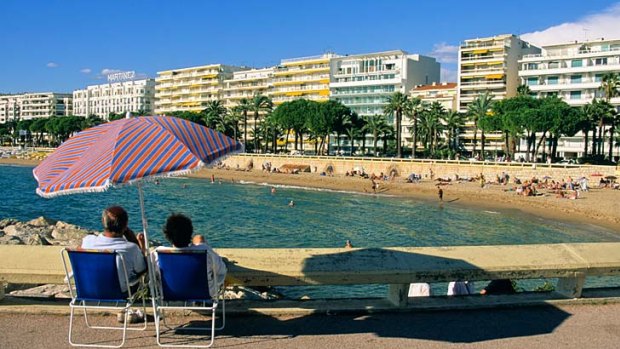
Star-gazing... Cannes lives for its 12 days of film magic.Credit: Alamy
Anthony Peregrine offers an insider's guide as the curtain rises on the Riviera resort.
Cannes plunges into the global limelight on May 16, when the 65th film festival kicks off. The jury president is Italian director and actor Nanni Moretti. He'll be followed by unbelievably famous people, all discoursing on the "magic of Cannes". The seaside town lives for these 12 days; it depends on them utterly, making the sparkle last for the year.
Certainly, the place has a grandiose bay, sandy beaches and a 180-year-old record of hosting the well heeled. But so do other spots on the Mediterranean. What distinguishes Cannes is the spinoff glamour with which it coats itself. Everyone should go once, if only to see how the trick is performed - but perhaps not at festival time. Hotels hike their prices skywards and, anyway, were booked long ago. June is perhaps the loveliest time on the Cote d'Azur.

Brad Pitt and Angelina Jolie at the Cannes Film Festival.Credit: Getty Images
Staying there
Near the Croisette, Le Cavendish is a cracking four-star where guests are welcomed into what appears to be a privately owned mansion. The 34 rooms are inspired by the Belle Epoque but filtered through a contemporary sensitivity. (Double rooms from £135 a night ($210); see cavendish-cannes.com.)
Le Mistral, a belting little two-star on a buzzy commercial street in the centre and two minutes from the seafront, underlines how far the town's budget hotels have progressed since the days of dodgy plumbing. (Rooms from £103; see www.mistral-hotel.com.)
The Alnea is also centrally located, bright as a pin, clean and much more jolly and welcoming than you would expect for the price. (Rooms from £78; see hotel-alnea.com.)
For first-timers
You'll want to start by the seaside and, particularly, at the Palais des Festivals, on whose steps every star in history has posed. Painted white in recent times, it looks less like a nuclear power plant. Still not very glamorous, though, unless Angelina Jolie is to hand.
Continue on to La Croisette promenade, where everything comes right. Curving elegantly around the bay, this is the stage for the spectacle that is Cannes: sun-spangled briny to the right, palace hotels to the left and, in between, snippets of parkland. Everyone's here - the rich and beautiful, families, joggers and chaps forlornly flogging sunglasses.
Beach restaurants can be crummy, but Plage l'Ondine, on La Croisette, opposite the end of Rue Pasteur, is the real deal for lunch (mains from £24; see ondineplage.com).
The Suquet hill district, rising back from the port, has hard-sloping streets and stairways coated with jovial bars, restaurants and shops that sell postcards and Provencal stuff. "Touristy", indeed - but we're all tourists here and the surroundings are both convivial and atmospheric.
Weave your way to the top and the mediaeval chateau that houses the Musee de la Castre. It is Cannes's only significant monument, has an eclectic collection of ethnic art and artefacts, musical instruments and anything else the town had to hand, and the views from its tower are outstanding (entry £5; ; see cannes.com). Suddenly, Cannes shows a bit of depth.
Wise owls say the restaurants at Suquet hill are tourist traps. Dine at Le Cosi (from £33, 12 Rue du Suquet; see lecosi.fr) or Le Mesclun (16 Rue St Antoine; see lemesclun-restaurant.com) and you'll never trust a wiseacre again. Both have elegance, panache and imagination. Le Cosi offers a vegetarian menu.
Next morning, nip out to the lower slopes of the Croix des Gardes hill, where British nobles established themselves in the mid-19th century. Thus began the fashioning of Cannes for the fashionable. Some original villas remain, including that of former lord chancellor Lord Brougham, the first grandee to favour Cannes. (You must trespass through the private development at 24 Avenue Dr Picaud to see the ochre, classical mansion.)
Continue exploring the vast parkland on top of the hill or return to town for shopping. Big-brand boutiques have a stand-offish presence on La Croisette. More reasonable retailing lines the Rue d'Antibes behind. Rue Meynadier assembles good food shops and leads to the Forville market. Pick up the makings of a picnic, head to the port and Quai Laubeuf for a ferry to the Ile St Honorat. Pick out an island cove and settle in for the picnic.
The smaller of the two islands just off Cannes (you can lap it in 45 minutes), St Honorat is run by Cistercians, who expect modesty of dress (no toplessness) and calmness of behaviour of their visitors. In return, they offer peace, woodland, a low, rocky and unblemished coast and what's left of a mediaeval monastery fortified against Saracens. The more modern monastery shop sells the monk-made island wines (from £30 a bottle), so leave vows of poverty behind. Sadly, you can't make a round-trip visit to the other island, Ile Ste Marguerite, so return to Cannes for aperitifs by the port.
Try dinner at the elegant l'Affable (from £34; 5 Rue Lafontaine; see restaurant-laffable.fr). If you have energy to spare, bars and clubs around Rue Commandant Andre will drain it with pleasure.
Nice airport is 30 minutes' drive from Cannes; trains from Paris and regions of the Mediterranean run daily to Cannes. See cannes.fr.
- Telegraph, London
Sign up for the Traveller Deals newsletter
Get exclusive travel deals delivered straight to your inbox. Sign up now.